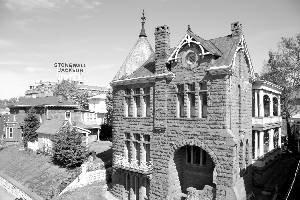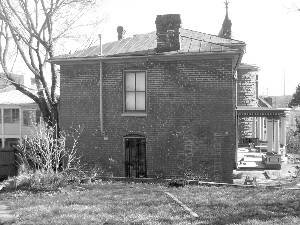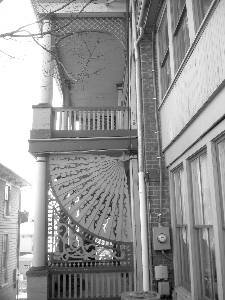REAL ESTATE- ON THE BLOCK- Fit for a king: Kalorama Castle, one of a kind
ADDRESS: 215 Kalorama Street
NEIGHBORHOOD: Staunton
ASKING: $650,000
CITY ASSESSMENT: $206,120
YEAR BUILT: 1882/1891
SIZE: 3,963 fin. sq. ft.
LAND: 0.182 acres
CURB APPEAL: 8 out of 10
LISTED BY: Denise Gauthier, Regal Real Estate Inc. 540-885-7500, cell 540-294-0468
Okay, folks, here it is. Over the years, in addition to scores of bungalows, ranches, cottages, farm houses, green buildings, flour mills, railroad stations, and miscellaneous multimillion-dollar extravaganzas, On the Block has reviewed a bomb shelter, an ersatz geodesic dome, and a power plant. But never a castle– until now.
This Kalorama Castle, as its known in Staunton, is not your run-of-the-mill Sleeping Beauty model, however, with peaks, flag-flying turrets, and moat. This castle began in 1882 as a brick Italianate residence to which an imposing rough-cut brownstone Richardsonian Romanesque faade was added in 1891. No princesses in evidence.
Arista Hoge, a successful insurance agent and treasurer of the city of Staunton in the late 19th century, apparently grew tired of the marginally sumptuous brick house he had James Bumgardener Jr. build for him in 1882. So after only eight years, he hired an expatriate Washington, D.C. architect, T.J. Collins, to design a new front.
Collins– true to his big-city raisin– added a two-bay brownstone faade, the left bay topped by a turret, a conical slate roof, and a finial, with a set of narrow triple windows on each of the three floors.
A new entrance was created in the right bay under a two-story Syrian arch with a keystone adorned with Hoges carved initials. Above the arch, a little attic gable window tops the triple windows. A stone chimney separates the two bays.
Porches were added on each side of the house, the one on the right sporting Queen Anne trim and an extraordinary Art Nouveau millwork fan with adjustable louvers, unique in Staunton– and possibly in Virginia. (Surely, we at On the Block have never seen anything like it.)
Continuing the frou-frou effect, iron scrollwork encloses a front balcony.
The castle is just as startlingly unusual inside. While all the floors (except bathrooms and kitchen) are wood (narrow oak strips in the dining room, traditional oak elsewhere downstairs, wide heart pine on the second level), the wood in a library room behind the new entrance (new in 1882!) is the most impressive: elaborate oak parquet with a complicated design. Etched glass in the doors contributes to the sophistication of this small jewel of a room.
To the left of the entry, a large oval ballroom has 12-foot ceilings, a mantel with beveled mirror over one of eight fireplaces in the house (alas, only one works), and an unusual large circular mesh radiator that somewhat brightens the dark space made even gloomier by big interior shutters.
Next is the living room with another fireplace and a French door to a wide-bay side porch with supporting Tuscan columns. What little yard there is is here (theres a little bit more in the back). Through large pocket doors, the dining room holds a table made specifically for it– and thus potentially problematic to remove. Exposed dark beams give this room a Henry VIII-ish feel.
The kitchen has a new tile floor and glass-front cabinets, but not much else to recommend it.
This rear section of the house– which is in fact the original building– is going to need the most work. A half bath with a washer/dryer up a few steps from an enclosed side porch is in desperate shape, although the porch itself, with huge, almost floor-to-ceiling windows, is bright and ripe with potential.
This room leads back to the lovely parquet-floor library with stairs to the second level and a door to the two-story wooden east porch. Like the west porch, this one has Tuscan columns, but the lacy Queen Anne latticework and the amazing wooden filigree fan make this a truly unique space. Other houses may have parquet floors, over-the-door transoms, high ceilings– perhaps even a circular mesh radiator. But no house has a fan like this.
Upstairs, a huge hall leads forward to two bedrooms, one with a built-in sink and one with its own fireplace. At the end of the hall a full bath has been redone with marble floor and new fixtures. A little study, nursery, office, or sewing room (maybe even a small sixth bedroom) connects to the master suite across the front of the house– and both rooms have the triple-window groupings and 14-foot ceilings.
Now just when the place has begun to feel somewhat like a real house– albeit massive and wildly embellished– here in the bedroom we find a marble monument embedded the wall. Seems Arista Hoge was also on the board of the Thorn Rose Cemetery, and was able to prevail upon one of the tombstone craftsmen to adorn his bedroom with a memento mori of his very own.
Two more bedrooms (one with a weird overflow water tank in the corner), and the third full bath are back in the original part of the house on this level (over the kitchen), and the long hall benefits, like the enclosed porch downstairs, from a similar wall of windows. Central air has been added here (but not in the rest of the house), and theres pull-down attic access that leads to the turret.
The first floor (ground level) is where the current residents seem to have spent most of their energy and renovation money. A large carpeted oval office under the ballroom has a separate entrance and the only working (gas) fireplace.
Much about the Kalorama Castle is indeed fit for a king. But it will have to be a king with tax revenues from a large duchy if he wants to return this house to its regal original condition. Theres a lot to work with, but also a lot of work to be done.


 PHOTOS BY ROSALIND WARFIELD-BROWN
PHOTOS BY ROSALIND WARFIELD-BROWN
#